FORD CONTOUR 1998 2.G Repair Manual
Manufacturer: FORD, Model Year: 1998, Model line: CONTOUR, Model: FORD CONTOUR 1998 2.GPages: 200, PDF Size: 2.7 MB
Page 61 of 200
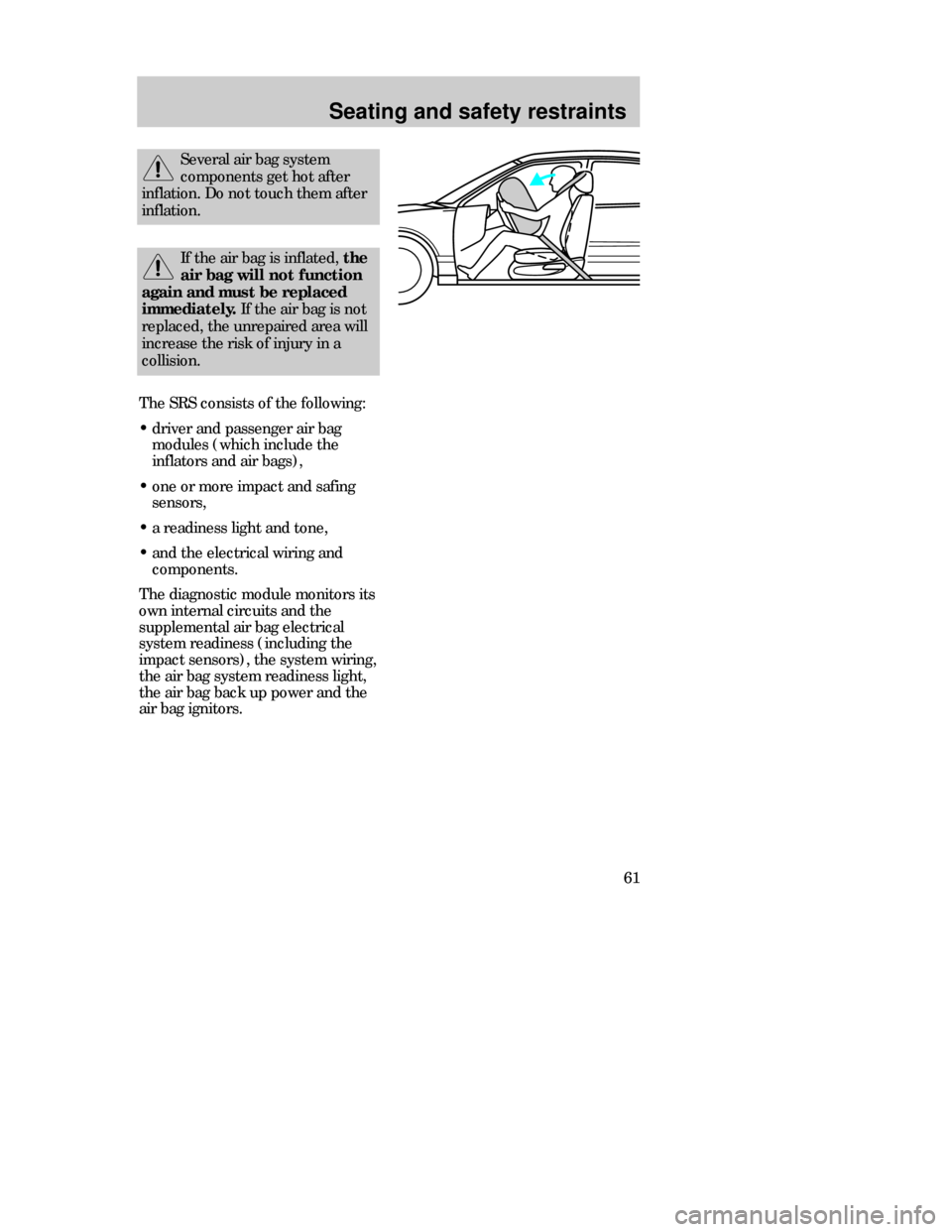
Seating and safety restraints
61
If the air bag is inflated, the
air bag will not function
again and must be replaced
immediately.If the air bag is not
replaced, the unrepaired area will
increase the risk of injury in a
collision.
The SRS consists of the following:
•driver and passenger air bag
modules (which include the
inflators and air bags),
•one or more impact and safing
sensors,
•a readiness light and tone,
•and the electrical wiring and
components.
The diagnostic module monitors its
own internal circuits and the
supplemental air bag electrical
system readiness (including the
impact sensors), the system wiring,
the air bag system readiness light,
the air bag back up power and the
air bag ignitors.
Several air bag system
components get hot after
inflation. Do not touch them after
inflation.
CDW IIID Seat en C 5/15/97 8:48 PM Page 61
Page 62 of 200
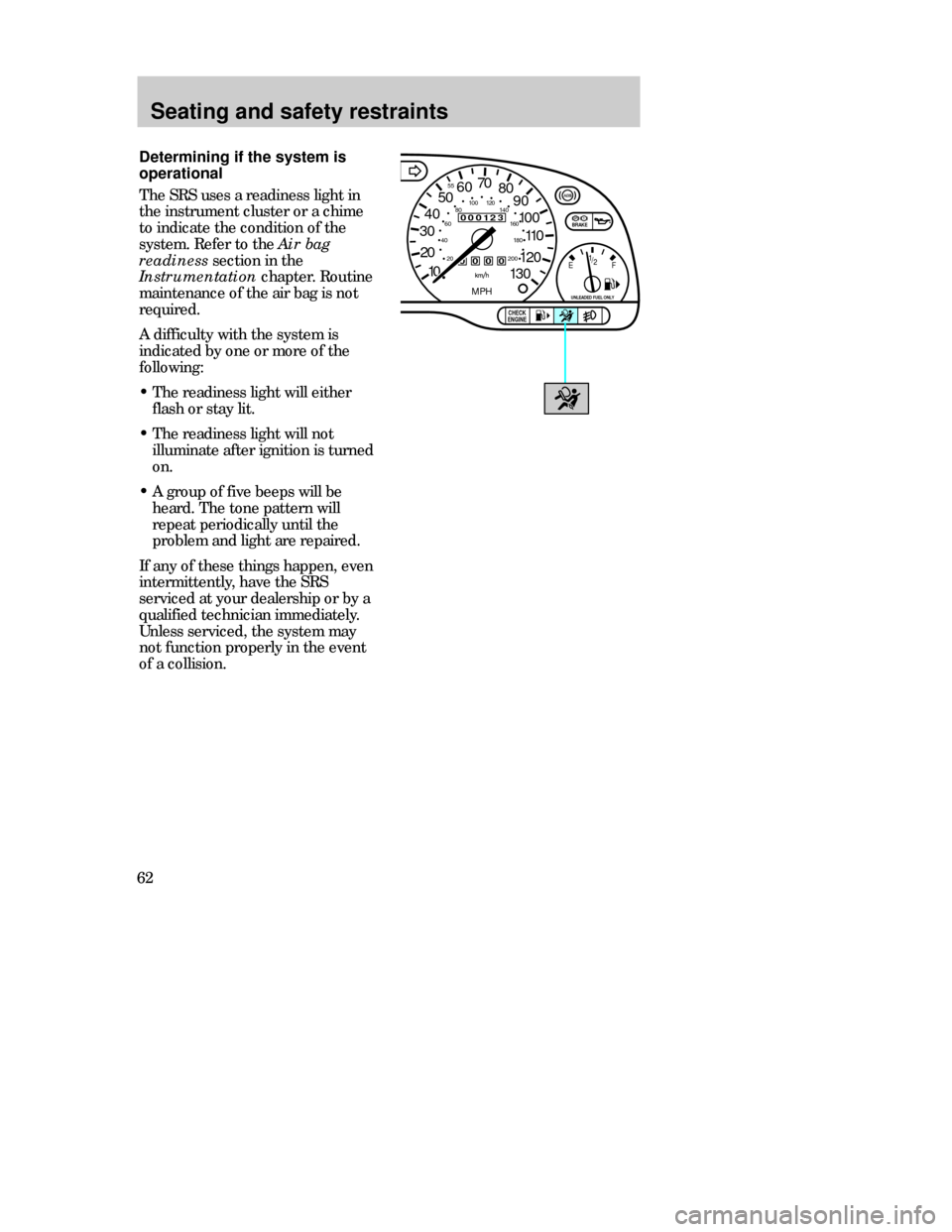
Seating and safety restraints
62Determining if the system is
operational
The SRS uses a readiness light in
the instrument cluster or a chime
to indicate the condition of the
system. Refer to the Air bag
readinesssection in the
Instrumentationchapter. Routine
maintenance of the air bag is not
required.
A difficulty with the system is
indicated by one or more of the
following:
•The readiness light will either
flash or stay lit.
•The readiness light will not
illuminate after ignition is turned
on.
•A group of five beeps will be
heard. The tone pattern will
repeat periodically until the
problem and light are repaired.
If any of these things happen, even
intermittently, have the SRS
serviced at your dealership or by a
qualified technician immediately.
Unless serviced, the system may
not function properly in the event
of a collision.
000123
000010 20 3040506070
80
90
110
120
130
MPH
20 4060
55
80120 100
140
160
180
200100
EF 1
/
2
UNLEADED FUEL ONLY
BRAKE
CHECK
ENGINE
CDW IIID Seat en C 5/15/97 8:48 PM Page 62
Page 63 of 200
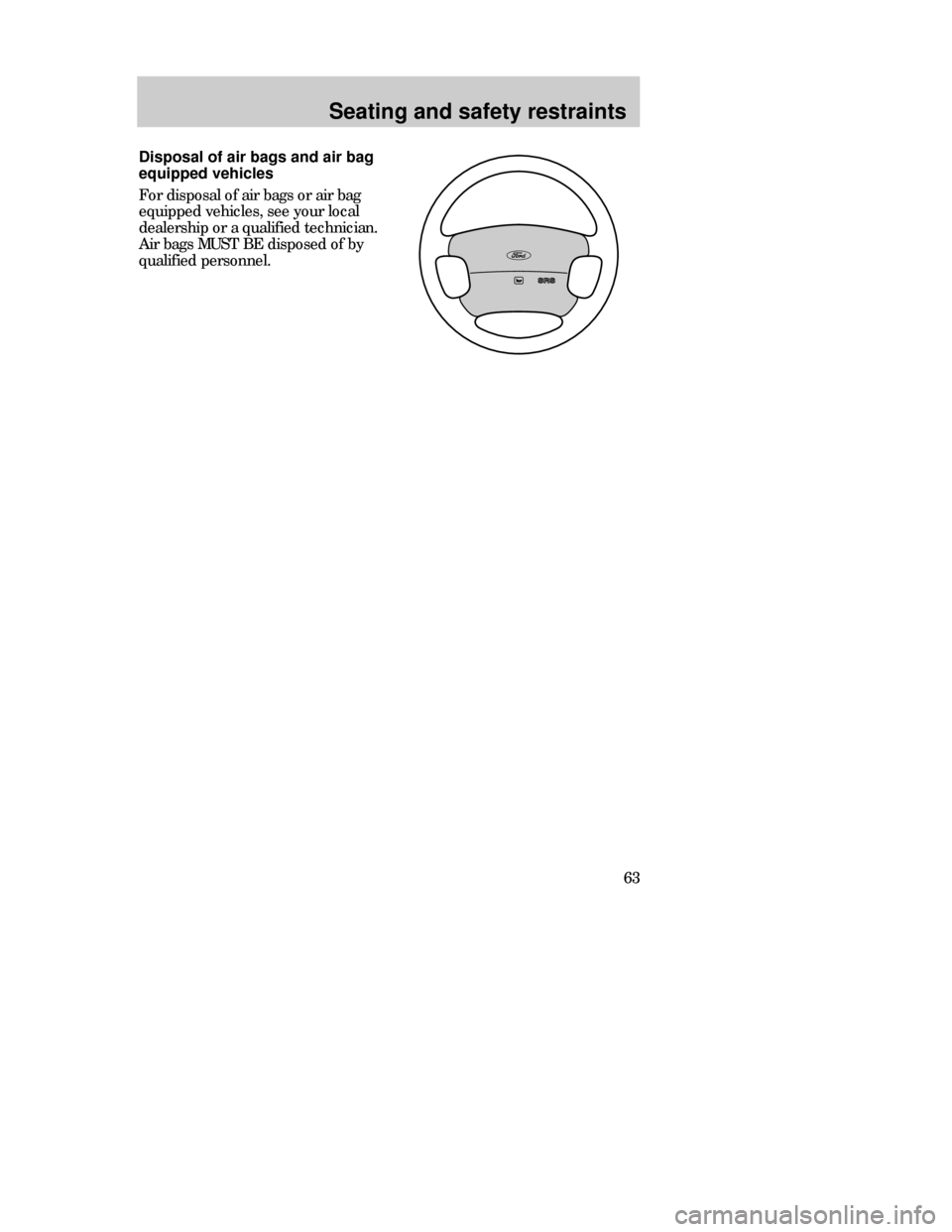
Seating and safety restraints
63 Disposal of air bags and air bag
equipped vehicles
For disposal of air bags or air bag
equipped vehicles, see your local
dealership or a qualified technician.
Air bags MUST BEdisposed of by
qualified personnel.
CDW IIID Seat en C 5/15/97 8:48 PM Page 63
Page 64 of 200
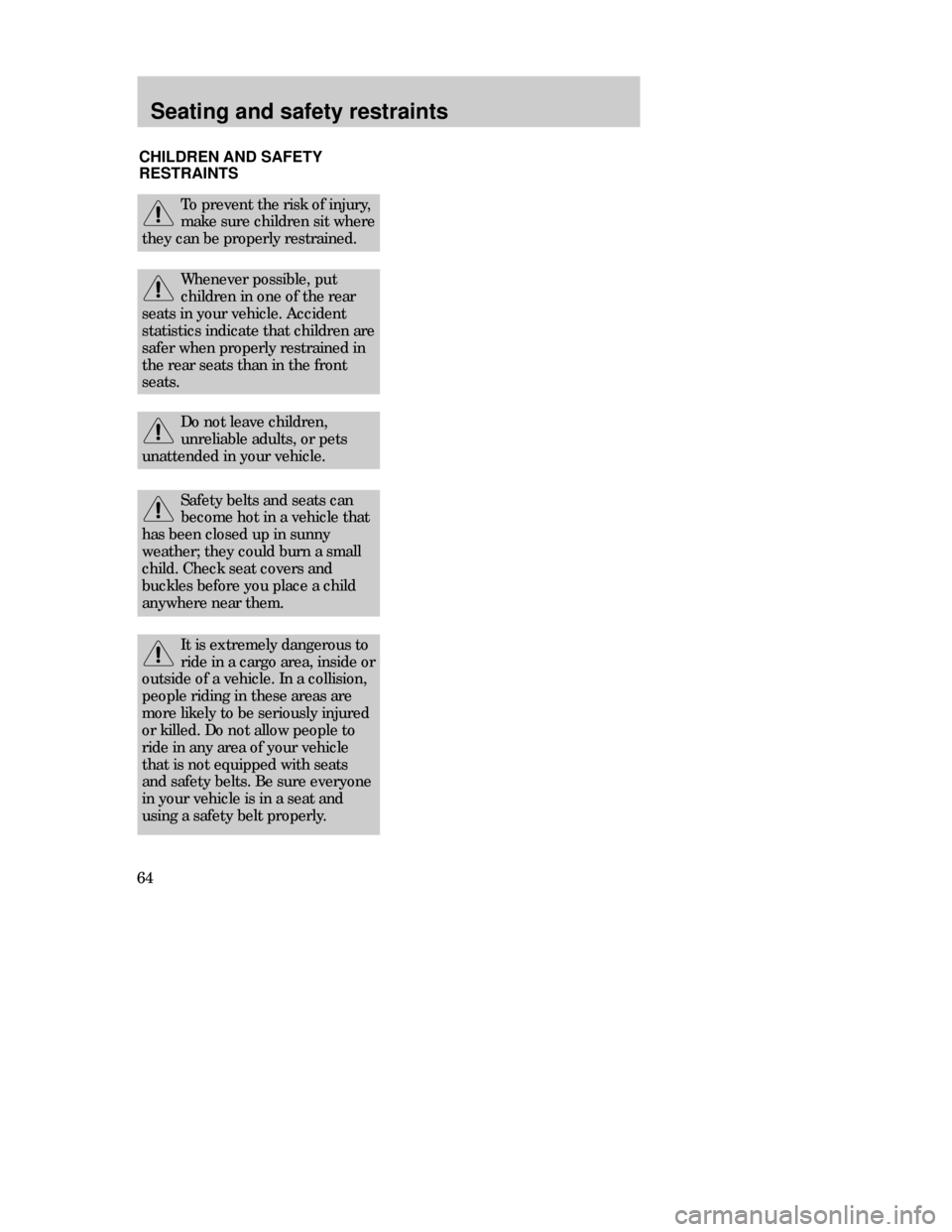
Seating and safety restraints
64
Safety belts and seats can
become hot in a vehicle that
has been closed up in sunny
weather; they could burn a small
child. Check seat covers and
buckles before you place a child
anywhere near them.
Do not leave children,
unreliable adults, or pets
unattended in your vehicle.
To prevent the risk of injury,
make sure children sit where
they can be properly restrained.
CHILDREN AND SAFETY
RESTRAINTS
It is extremely dangerous to
ride in a cargo area, inside or
outside of a vehicle. In a collision,
people riding in these areas are
more likely to be seriously injured
or killed. Do not allow people to
ride in any area of your vehicle
that is not equipped with seats
and safety belts. Be sure everyone
in your vehicle is in a seat and
using a safety belt properly.
Whenever possible, put
children in one of the rear
seats in your vehicle. Accident
statistics indicate that children are
safer when properly restrained in
the rear seats than in the front
seats.
CDW IIID Seat en C 5/15/97 8:48 PM Page 64
Page 65 of 200
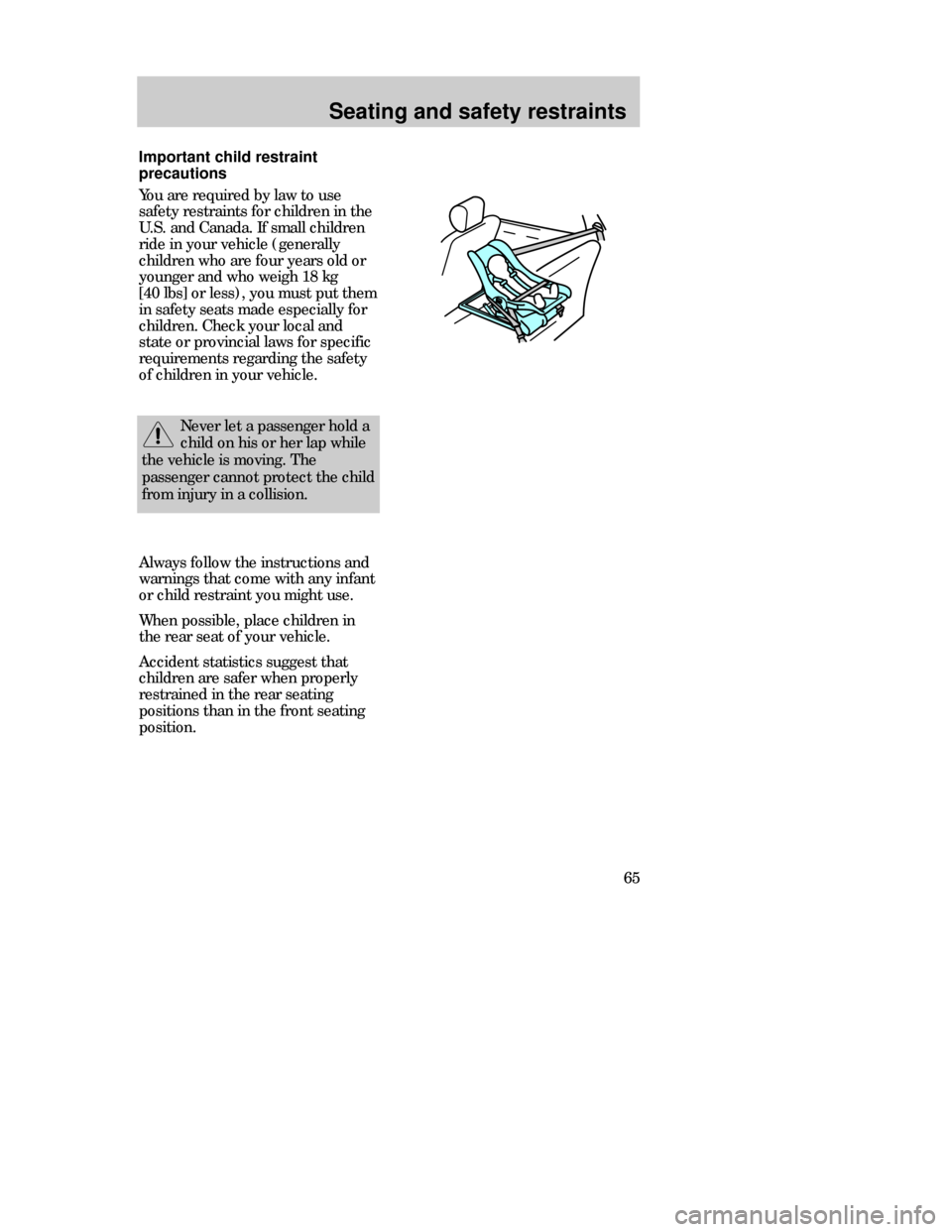
Seating and safety restraints
65 Important child restraint
precautions
You are required by law to use
safety restraints for children in the
U.S. and Canada. If small children
ride in your vehicle (generally
children who are four years old or
younger and who weigh 18 kg
[40 lbs] or less), you must put them
in safety seats made especially for
children. Check your local and
state or provincial laws for specific
requirements regarding the safety
of children in your vehicle.
Never let a passenger hold a
child on his or her lap while
the vehicle is moving. The
passenger cannot protect the child
from injury in a collision.
Always follow the instructions and
warnings that come with any infant
or child restraint you might use.
When possible, place children in
the rear seat of your vehicle.
Accident statistics suggest that
children are safer when properly
restrained in the rear seating
positions than in the front seating
position.
CDW IIID Seat en C 5/15/97 8:48 PM Page 65
Page 66 of 200
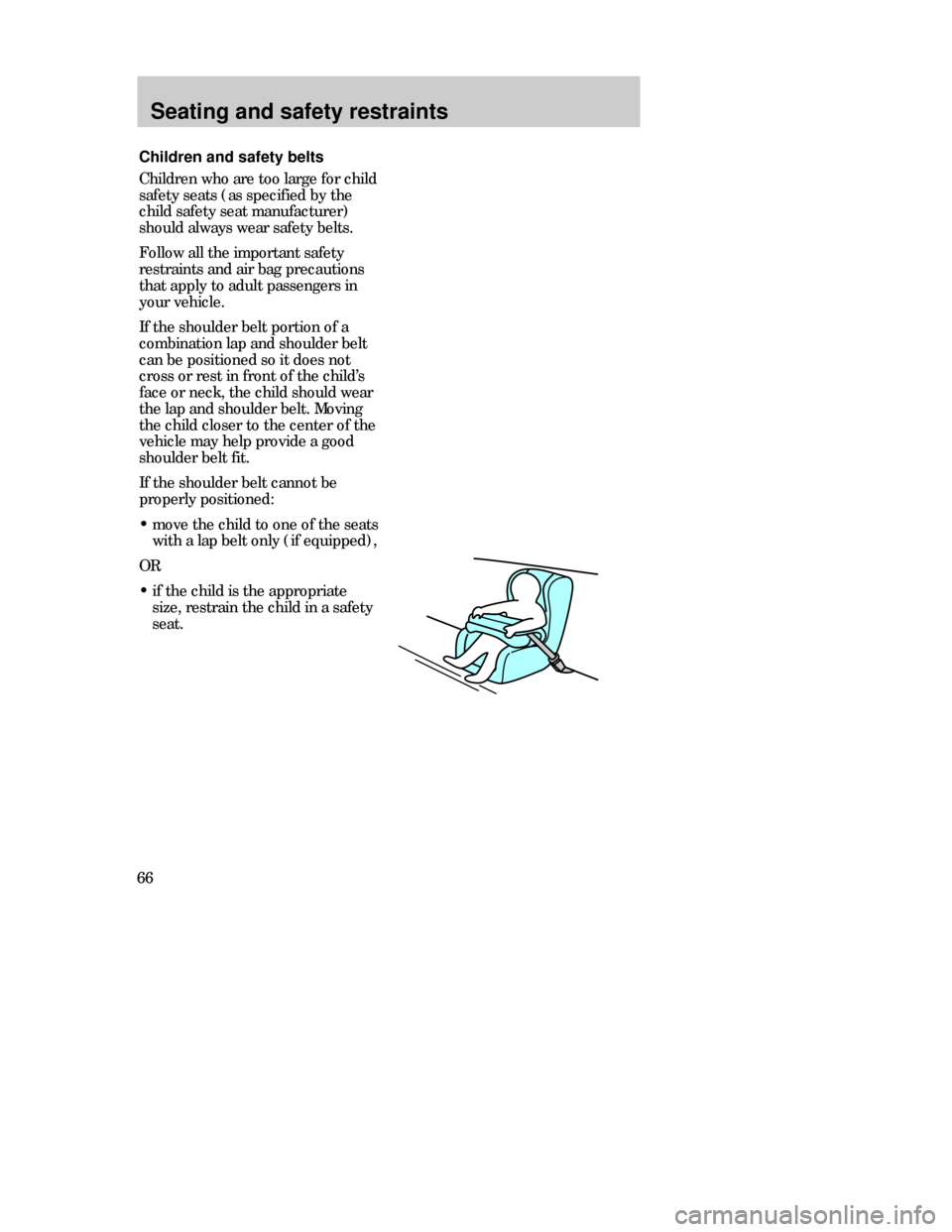
Seating and safety restraints
66Children and safety belts
Children who are too large for child
safety seats (as specified by the
child safety seat manufacturer)
should always wear safety belts.
Follow all the important safety
restraints and air bag precautions
that apply to adult passengers in
your vehicle.
If the shoulder belt portion of a
combination lap and shoulder belt
can be positioned so it does not
cross or rest in front of the child’s
face or neck, the child should wear
the lap and shoulder belt. Moving
the child closer to the center of the
vehicle may help provide a good
shoulder belt fit.
If the shoulder belt cannot be
properly positioned:
•move the child to one of the seats
with a lap belt only (if equipped),
OR
•if the child is the appropriate
size, restrain the child in a safety
seat.
CDW IIID Seat en C 5/15/97 8:48 PM Page 66
Page 67 of 200
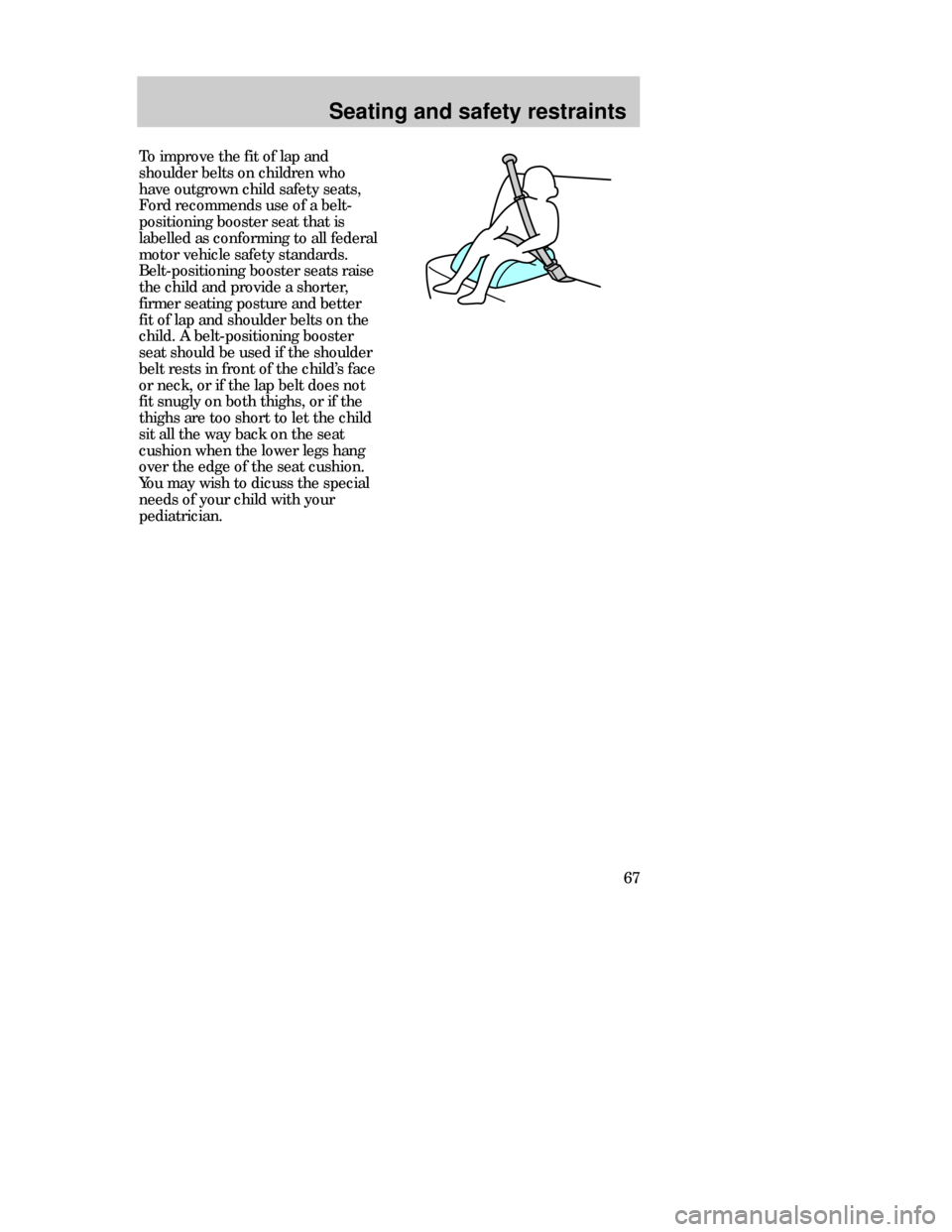
Seating and safety restraints
67 To improve the fit of lap and
shoulder belts on children who
have outgrown child safety seats,
Ford recommends use of a belt-
positioning booster seat that is
labelled as conforming to all federal
motor vehicle safety standards.
Belt-positioning booster seats raise
the child and provide a shorter,
firmer seating posture and better
fit of lap and shoulder belts on the
child. A belt-positioning booster
seat should be used if the shoulder
belt rests in front of the child’s face
or neck, or if the lap belt does not
fit snugly on both thighs, or if the
thighs are too short to let the child
sit all the way back on the seat
cushion when the lower legs hang
over the edge of the seat cushion.
You may wish to dicuss the special
needs of your child with your
pediatrician.
CDW IIID Seat en C 5/15/97 8:48 PM Page 67
Page 68 of 200
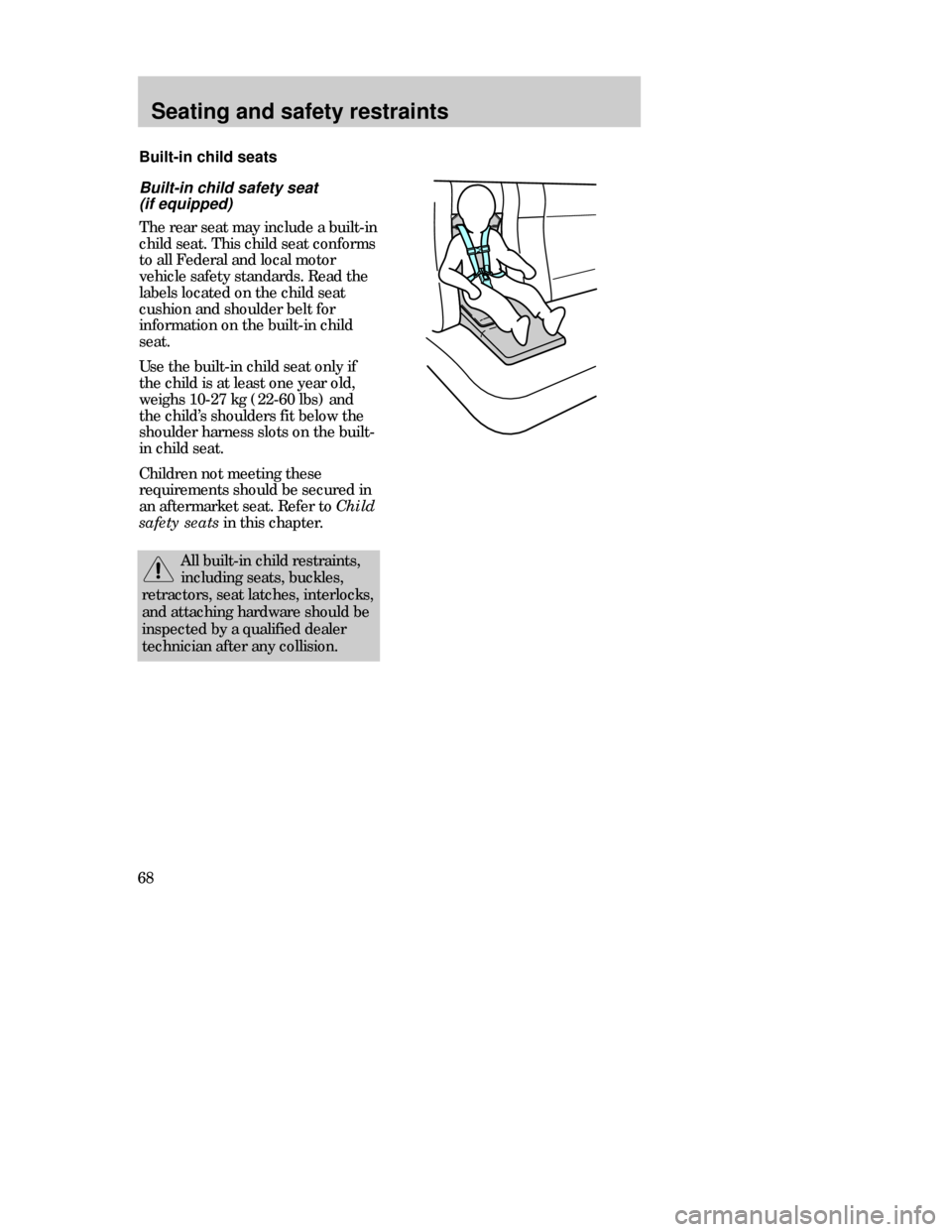
Seating and safety restraints
68
Built-in child safety seat
(if equipped)
The rear seat may include a built-in
child seat. This child seat conforms
to all Federal and local motor
vehicle safety standards. Read the
labels located on the child seat
cushion and shoulder belt for
information on the built-in child
seat.
Use the built-in child seat only if
the child is at least one year old,
weighs 10-27 kg (22-60 lbs) and
the child’s shoulders fit below the
shoulder harness slots on the built-
in child seat.
Children not meeting these
requirements should be secured in
an aftermarket seat. Refer to Child
safety seatsin this chapter. Built-in child seats
All built-in child restraints,
including seats, buckles,
retractors, seat latches, interlocks,
and attaching hardware should be
inspected by a qualified dealer
technician after any collision.
CDW IIID Seat en C 5/15/97 8:48 PM Page 68
Page 69 of 200
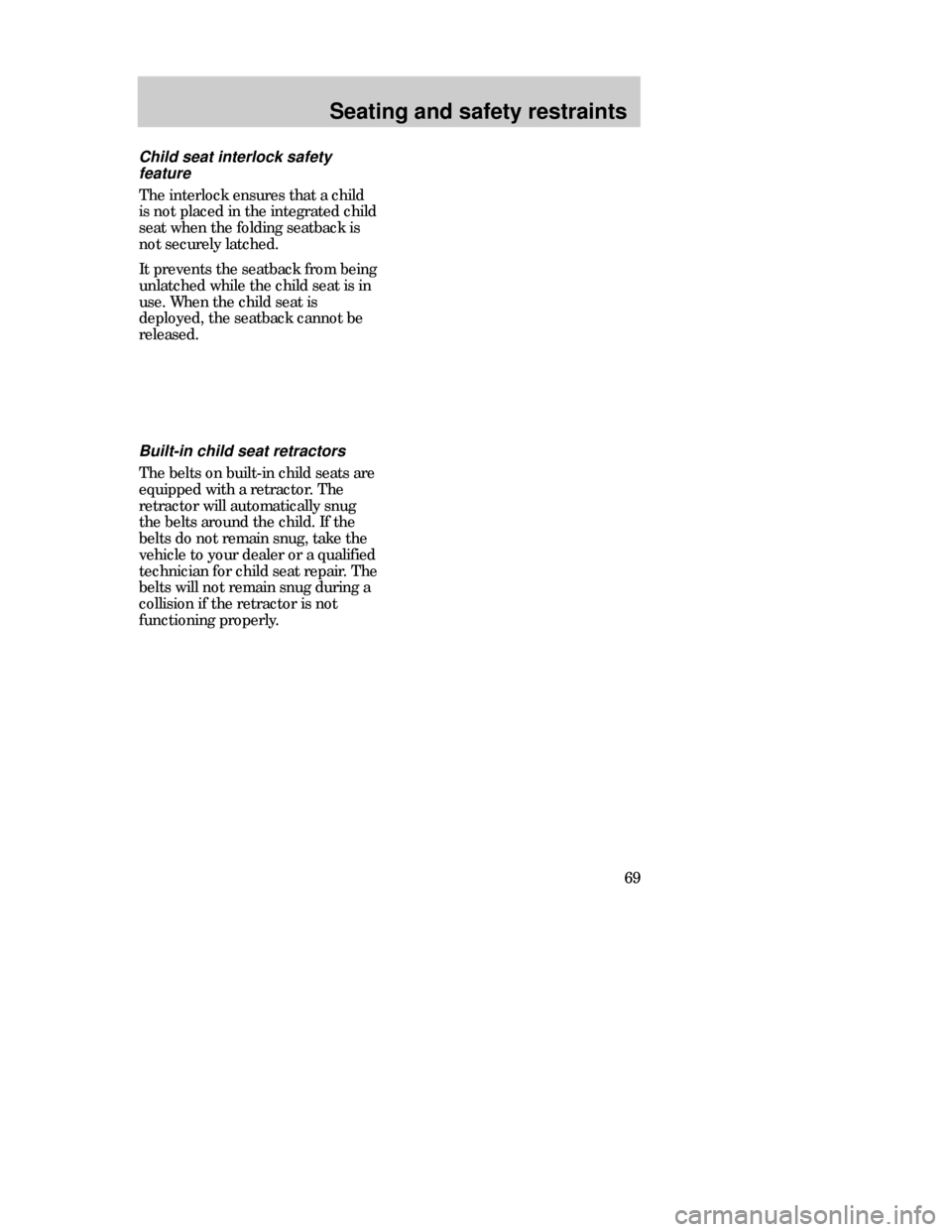
Seating and safety restraints
69
Child seat interlock safety
feature
The interlock ensures that a child
is not placed in the integrated child
seat when the folding seatback is
not securely latched.
It prevents the seatback from being
unlatched while the child seat is in
use. When the child seat is
deployed, the seatback cannot be
released.
Built-in child seat retractors
The belts on built-in child seats are
equipped with a retractor. The
retractor will automatically snug
the belts around the child. If the
belts do not remain snug, take the
vehicle to your dealer or a qualified
technician for child seat repair. The
belts will not remain snug during a
collision if the retractor is not
functioning properly.
CDW IIID Seat en C 5/15/97 8:48 PM Page 69
Page 70 of 200
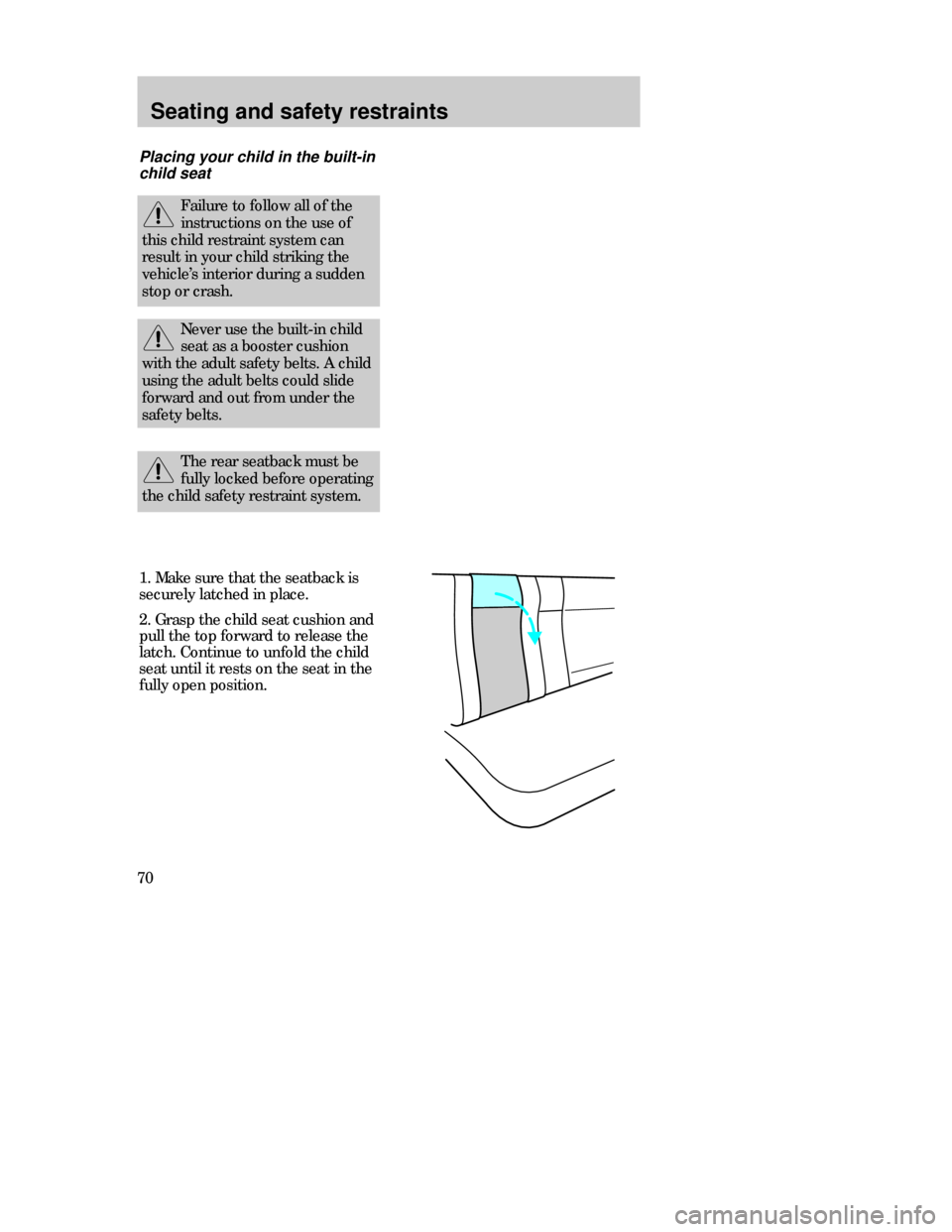
Seating and safety restraints
701. Make sure that the seatback is
securely latched in place.
2. Grasp the child seat cushion and
pull the top forward to release the
latch. Continue to unfold the child
seat until it rests on the seat in the
fully open position.
Placing your child in the built-in
child seat
Failure to follow all of the
instructions on the use of
this child restraint system can
result in your child striking the
vehicle’s interior during a sudden
stop or crash.
Never use the built-in child
seat as a booster cushion
with the adult safety belts. A child
using the adult belts could slide
forward and out from under the
safety belts.
The rear seatback must be
fully locked before operating
the child safety restraint system.
CDW IIID Seat en C 5/15/97 8:48 PM Page 70